Why Do I Need to Install Fedora Again and Again in Vm Virtualbox
This article has been checked and updated in January 2020 for correctness.
There are many ways to give Fedora a try if you are currently using another operating system. 1 way that volition have little impact on your electric current operating arrangement is to create a alive USB of Fedora, and boot directly into information technology. Alternatively, you could employ virtualization engineering such equally VirtualBox to run a Fedora install. The virtualization arroyo allows y'all piece of work on on your Fedora install without haveing to to reboot the system every time you need to use Fedora. Additionally, even if your master operating system is Fedora or not, and yous want to do some hack or test some software on a spare installation without harming your main system, having the selection to start from zero again and once again without losing your other works. Y'all can even restore a fill-in of your virtualized organization if something in your exam goes wrong.
Note that if you are currently running Fedora as your main machine, VirtualBox may not be the best choice for virtualization, because it is not in the Fedora repositories. In this instance, using KVM / Libvirt is probably a better approach. Still, if your main organization is Windows or OSX, y'all tin apply VirtualBox to create a Fedora invitee.
What is VirtualBox
Oracle VM VirtualBox is, equally stated in the homepage "a powerful x86 and AMD64/Intel64 virtualization production for enterprise too as home utilize". Virtualization lets you to run an entire operating arrangement within a virtual machine. A virtual car is a piece of software that runs on top of your system and, in brief,emulates a PC hardware (still, in reality the subject is a picayune bit more circuitous).
You can install the VirtualBox software, configure a virtual machine, and run another operating organization, like installing it on another PC. You can configure the virtual car (VM) configuring various kind of hardware: how much RAM, what kind of chipset (PIIX3 or ICH9), how many (virtual) CPUs, upwards to four network cards and which model, how many (virtual) hard disks, boot social club, audio device and a bunch of other things.
Y'all can install as many VMs y'all want, and run them at the same time, well, in this instance as many every bit your physical hardware is able to support (you can imagine what happens if you try to start ten VMs with 1GB of RAM each, and your PC accept 4GB of RAM).
VirtualBox is a multi platform software: in the sense that information technology is released for a lot of operating systems (Linux, Windows, MacOS and Solaris/Illumos). VirtualBox is developed past Oracle and, since version 4, information technology is free software released nether the GNU Full general Public License version 2 (GPLv2).
Installing Fedora as a VirtualBox guest
Get-go Oracle VM VirtualBox Managing director
In this tutorial, nosotros assume you already have VirtualBox installed. Information technology is a straightforward task: download the Windows or MacOS 10 installer from the VirtualBox website. Generally speaking, the version that yous tin download from the Oracle VirtualBox website is more recent than the one yous can find in tertiary party repositories.
Once VirtualBox is installed, start it, and you will encounter the configuration and management dashboard: Oracle VM VirtualBox Manager. Also this interface is pretty simple and straightforward.
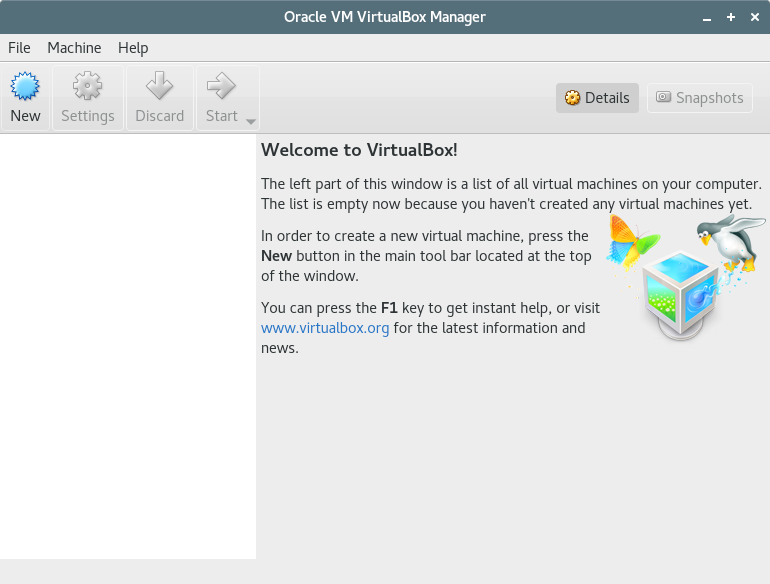
Download the Fedora ISO
In order to install Fedora, you lot need the installation media. You can download Fedora from https://getfedora.org/ Any of the Fedora downloads will piece of work. You can grab the total Fedora Workstation ISO, the slim netinstall ISO, or fifty-fifty a spin of the Fedora desktop environment: maybe XFCE or LXDE desktop surround volition runs smoothly inside a virtualized platform.
Create an empty virtual automobile
The graphical interface volition guide you through the VM cosmos. Basically the default options should fit your basic needs.
Click on the "New" icon. Write the name of the VM. Blazon and Version should exist automagically reverberate the operating system you are going to install: based on this, some bones options will be automatically adjusted to fit the operating system minimal requirements.
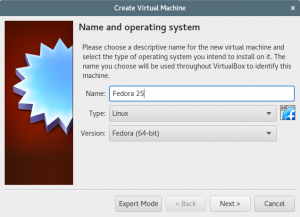
Click on "Next". Now you must select the amount of RAM to assign to the VM. Please notation that the more you assign to the VM, the bottom will remains to your host operating organization: if in that location is a lack of available memory on the host Os, the system will showtime to bandy, affecting fifty-fifty the VM performances. And so pay attending in balancing the RAM size of the VM: however the configuration interface will alert you if you are exaggerating. By the manner 1024 MB is a good starting point.
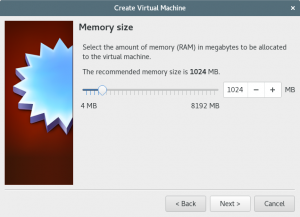
Now it is time to configure the VM disk. Default choiches are ok, except for the size: 8GB is as well small for a usable Fedora workstation, so permit's use at to the lowest degree 20GB. Also in this case, you are taking up space to the host system: you must have that into account if you are planning to use many virtual machines or y'all're curt in disk infinite.
Remember that you can add equally many (virtual) disks as you want. So, for example, if you finish up filling the virtual car disk space, y'all tin can add a second disk. It is more easy than adding an hard disk to your desktop PC or your notebook.
Prepare to start with the automobile configuration
The virtual machine is at present ready. You tin can change some options past clicking the Settings choice from the toolbar.

Network
The network options permit yous to configure more than one interface, and the kind of network. Yous can configure your VM mainly in these ways:
- NAT: the VM will be like in a private network non accessible from the outside. It can freely reach the same sites you are allowed to with your host syestem. The VM will become an IP from the VirtualBox internal DHCP, then, to go along the network, such accost will be translated in the IP of the host system. This option is suitable if yous have not to reach the VM from the rest of the network, i.e. you don't run network services on the VM. At the aforementioned time you lot can reach the outside network.
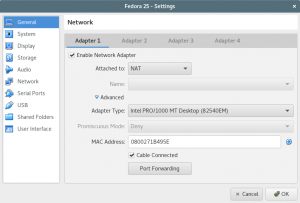
- Bridged Adapter: in this example you must call up as a new network carte on your host PC. The VM is directly attached to your LAN, so y'all must assign a static IP in the aforementioned subnetwork of the host system, or use your LAN DHCP. In this way the VM will take a reachable IP, at to the lowest degree from the LAN, so you can configure some network services and reach them from any host in the LAN.
In that location is a third way that worth mentioning. You tin configure the principal interface as NAT, and a 2nd interface as Host-but Adapter: in that way the VM tin reach the exterior network using NAT, simply information technology is at the aforementioned time reachable, but unlike Bridged manner, information technology is reachable solely and exclusively from your PC.
Installation media
You need to select the installation disk. So go in Storage and select the ISO file previously downloaded.
Select Empty in the IDE controller, then the CD icon. Select the ISO prototype and printing OK.
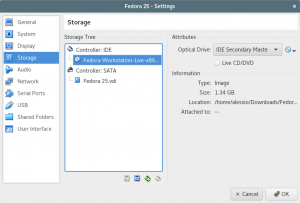
Start upwardly the VM and let'due south install Fedora
It is now the time to start the virtual car. By default it will showtime from the virtual CD. You must think to a virtual machine, like it is a physical ane: you tin can boot up, shut down gently, abruptly power off, information technology has memory, disks, network card, and even a sound card if you want.
Permit's click on the green arrow. The virtual machine will beginning.
You tin ignore the overlay bulletin complaining something related to mouse pointer and keyboard integration. Nosotros will manage to solve that later.

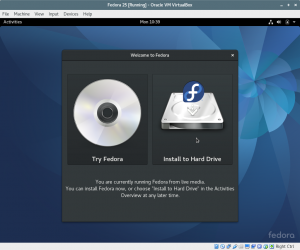
The kicking process begins and you tin can go ahead with the normal installation process.
You will encounter the (virtual) network interface, and the 20GB (virtual) Hard Deejay.
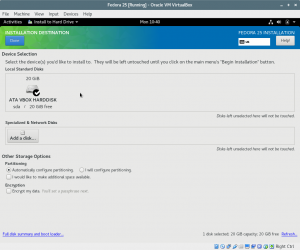
It is a good choice to leave the default partitioning scheme. In fact by default Fedora will set a LVM, logical volume manager. LVM could be useless in a notebook, where y'all volition never add together a 2nd hard drive. In a virtual machine you tin can hands add pretty as many disks as you desire, as said before, and so using LVM is a practiced option in order to farther expand bachelor filesystem space inside the VM.
Go ahead with the installation process and reboot the arrangement.
Final steps
Update Fedora
Equally for every installation, inside a VM or not, the first matter to do is a system update. Then login on Fedora with the user configured during the installation process and complete the first login steps. To update the Fedora install in your VM, open a Terminal and blazon:
sudo dnf -y update
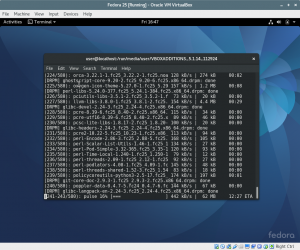
Installing the Guest Additions
VirtualBox Guest Additions are device drivers and system applications that assist to optimize the operating system installed inside the VM, useful for better functioning and usability, like a meliorate mouse and keyboard integration, window scaling and resizing, better video performances, and clipboard integration. Invitee Additions need to be installed within the VM, not on your host OS.
And then let'sinsert the Invitee AdditionsCD, by clicking on Devices -> Insert Guest Additions CD epitome… A window should appear asking you if you lot desire to allow autorun of the CD content.
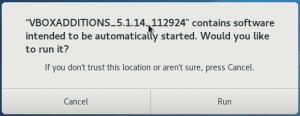
Click on "Cancel" because you lot demand to install some additional packages in order to fully install the Guest Additions.
Open a terminal and type, even if some packages may be already installed:
sudo dnf -y install gcc automake make kernel-headers kernel-devel perl
Once finished, actually install the Additions by running the script
sudo /run/media/user/VBOXADDITIONS*/VBoxLinuxAdditions.run
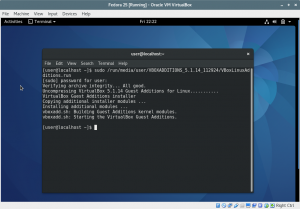
Reboot the VM.
Make a clone
The clone is a copy of the newly created automobile. When you are set up, stop the VM. In the Manager select the VM and in the Machine drop downward menù, select "Clone…"

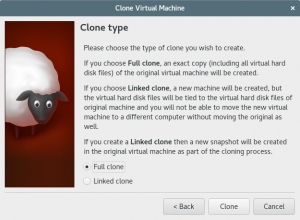
The main difference between Total and Linked clones is that latter cloning procedure is faster and consumes less size on your hard disk, at least initially, by contrast you cannot delete the virtual disk of the source VM, and cloned VMs cannot be exported to a different calculator without moving the original likewise.
Final thoughts
VirtualBox is a very convenient fashion to try Fedora if you don't already utilize it, whitout having to partition or format your PC or configuring dual booting. If you already are a Fedora user, VirtualBox is a very effective way for testing purposes without the fear to interruption your arrangement: y'all can reinstall the VM equally many times as you want, or better, as stated before, you can use clones to restart your examination from a fresh installation without wasting fourth dimension in the installation process.
Salve
Save
Salve
Salve
Save
Source: https://fedoramagazine.org/install-fedora-virtualbox-guest/
0 Response to "Why Do I Need to Install Fedora Again and Again in Vm Virtualbox"
Post a Comment